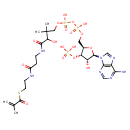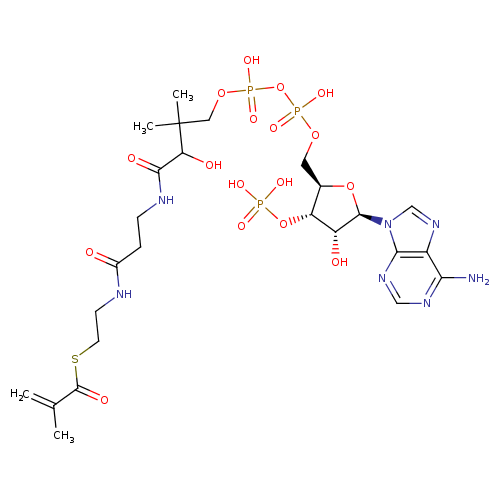|
Record Information |
|---|
| Version |
1.0 |
|---|
| Update Date |
1/22/2018 11:54:54 AM |
|---|
|
Metabolite ID | PAMDB110386 |
|---|
|
Identification |
|---|
| Name: |
methylacrylyl-CoA |
|---|
| Description: | Tetraanion of methacrylyl-CoA arising from deprotonation of the phosphate and diphosphate functions; principal microspecies at pH 7.3. |
|---|
|
Structure |
|
|---|
| Synonyms: | -
methacrylyl-CoA
-
2-methylprop-2-enoyl-CoA
-
methacrylyl-coenzyme A
|
|---|
|
Chemical Formula: |
C25H36N7O17P3S
|
|---|
| Average Molecular Weight: |
831.58 |
|---|
| Monoisotopic Molecular
Weight: |
835.1414231161 |
|---|
| InChI Key: |
NPALUEYCDZWBOV-NDZSKPAWSA-J |
|---|
| InChI: |
InChI=1S/C25H40N7O17P3S/c1-13(2)24(37)53-8-7-27-15(33)5-6-28-22(36)19(35)25(3,4)10-46-52(43,44)49-51(41,42)45-9-14-18(48-50(38,39)40)17(34)23(47-14)32-12-31-16-20(26)29-11-30-21(16)32/h11-12,14,17-19,23,34-35H,1,5-10H2,2-4H3,(H,27,33)(H,28,36)(H,41,42)(H,43,44)(H2,26,29,30)(H2,38,39,40)/p-4/t14-,17-,18-,19+,23-/m1/s1 |
|---|
| CAS
number: |
6008-91-9 |
|---|
| IUPAC Name: | 3'- phosphonatoadenosine 5'- phosphonatoadenosine 5'- {3- {3- [(3R)- [(3R)- 3- 3- hydroxy- hydroxy- 2,2- 2,2- dimethyl- dimethyl- 4- 4- {[3- {[3- ({2- ({2- [(2- [(2- methylprop- methylprop- 2- 2- enoyl)sulfanyl]ethyl}amino)- enoyl)sulfanyl]ethyl}amino)- 3- 3- oxopropyl]amino}- oxopropyl]amino}- 4- 4- oxobutyl] diphosphate} oxobutyl] diphosphate} |
|---|
|
Traditional IUPAC Name: |
[(2R,3S,4R,5R)-5-(6-aminopurin-9-yl)-4-hydroxy-2-[({hydroxy[hydroxy(3-hydroxy-2,2-dimethyl-3-{[2-({2-[(2-methylprop-2-enoyl)sulfanyl]ethyl}carbamoyl)ethyl]carbamoyl}propoxy)phosphoryl]oxyphosphoryl}oxy)methyl]oxolan-3-yl]oxyphosphonic acid |
|---|
| SMILES: | C=C(C(=O)SCCNC(=O)CCNC(=O)C(O)C(C)(C)COP(=O)(OP(=O)(OCC1(C(OP([O-])(=O)[O-])C(O)C(O1)N3(C2(=C(C(N)=NC=N2)N=C3))))[O-])[O-])C |
|---|
|
Chemical Taxonomy |
|---|
|
Taxonomy Description | This compound belongs to the class of chemical entities known as acyl coas. These are organic compounds containing a coenzyme A substructure linked to an acyl chain. |
|---|
|
Kingdom |
Chemical entities |
|---|
| Super Class | Organic compounds |
|---|
|
Class |
Lipids and lipid-like molecules |
|---|
| Sub Class | Fatty Acyls |
|---|
|
Direct Parent |
Acyl CoAs |
|---|
| Alternative Parents |
|
|---|
| Substituents |
- Coenzyme a or derivatives
- Purine ribonucleoside 3',5'-bisphosphate
- Purine ribonucleoside bisphosphate
- Purine ribonucleoside diphosphate
- Pentose phosphate
- Pentose-5-phosphate
- Ribonucleoside 3'-phosphate
- Beta amino acid or derivatives
- Glycosyl compound
- N-glycosyl compound
- Monosaccharide phosphate
- Organic pyrophosphate
- 6-aminopurine
- Pentose monosaccharide
- Imidazopyrimidine
- Purine
- Monoalkyl phosphate
- Aminopyrimidine
- Fatty amide
- Imidolactam
- Monosaccharide
- N-acyl-amine
- N-substituted imidazole
- Organic phosphoric acid derivative
- Alkyl phosphate
- Phosphoric acid ester
- Primary aromatic amine
- Pyrimidine
- Oxolane
- Azole
- Imidazole
- Heteroaromatic compound
- Amino acid or derivatives
- Thiocarboxylic acid ester
- Carboxamide group
- Carbothioic s-ester
- Secondary carboxylic acid amide
- Secondary alcohol
- Sulfenyl compound
- Thiocarboxylic acid or derivatives
- Organoheterocyclic compound
- Azacycle
- Oxacycle
- Carboxylic acid derivative
- Hydrocarbon derivative
- Alcohol
- Organic nitrogen compound
- Amine
- Organonitrogen compound
- Carbonyl group
- Organooxygen compound
- Organosulfur compound
- Organic oxygen compound
- Organopnictogen compound
- Primary amine
- Organic oxide
- Aromatic heteropolycyclic compound
|
|---|
| Molecular Framework |
Aromatic heteropolycyclic compounds |
|---|
| External Descriptors |
Not Available |
|---|
|
Physical Properties |
|---|
| State: |
Solid |
|---|
| Charge: | -4 |
|---|
|
Melting point: |
Not Available |
|---|
| Experimental Properties: |
| Property | Value | Reference |
|---|
| Melting Point | Not Available | Not Available | | Boiling Point | Not Available | Not Available | | Water Solubility | Not Available | Not Available | | LogP | Not Available | Not Available |
|
|---|
| Predicted Properties |
|
|---|
|
Biological Properties |
|---|
| Cellular Locations: |
Not Available |
|---|
| Reactions: | |
|---|
|
Pathways: |
- Valine, Leucine and Isoleucine Degradation pae00280
|
|---|
|
Spectra |
|---|
| Spectra: |
|
|---|
|
References |
|---|
| References: |
- Shimomura Y, Honda T, Goto H, Nonami T, Kurokawa T, Nagasaki M, Murakami T: Effects of liver failure on the enzymes in the branched-chain amino acid catabolic pathway. Biochem Biophys Res Commun. 2004 Jan 9;313(2):381-5. [14684172 ]
- Lehnert W, Sass JO: Glutaconyl-CoA is the main toxic agent in glutaryl-CoA dehydrogenase deficiency (glutaric aciduria type I). Med Hypotheses. 2005;65(2):330-3. [15922108 ]
- Taniguchi K, Nonami T, Nakao A, Harada A, Kurokawa T, Sugiyama S, Fujitsuka N, Shimomura Y, Hutson SM, Harris RA, Takagi H: The valine catabolic pathway in human liver: effect of cirrhosis on enzyme activities. Hepatology. 1996 Dec;24(6):1395-8. [8938168 ]
|
|---|
| Synthesis Reference: |
Hawes, John W.; Harper, Edwin T. Synthesis of methacrylyl-CoA and (R)- and (S)-3-hydroxyisobutyryl-CoA. Methods in Enzymology (2 |
|---|
| Material Safety Data Sheet (MSDS) |
Not Available |
|---|
|
Links |
|---|
| External Links: |
|
|---|


